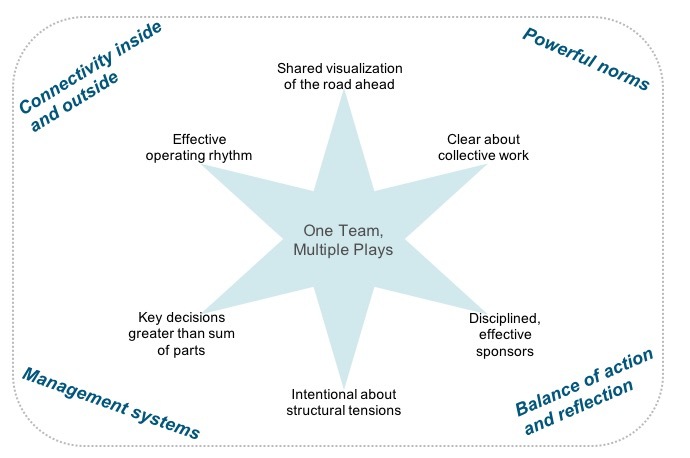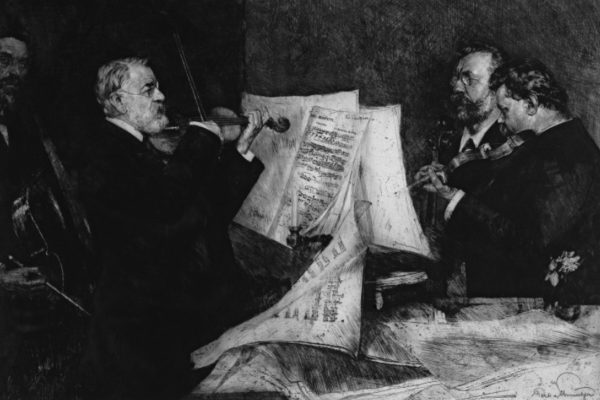
Perhaps nothing is as important to an organization’s success as the quality of its leadership team and how this team functions together. Few leadership teams, however, have clearly articulated their collective role and few have established the disciplines required to play this role well.
In an earlier post, I defined seven key elements of the work of an enterprise leadership team:
- Shape the enterprise’s vision, strategy and way of operating
- Translate the vision into principal objectives, and the way of operating into specific standards and practices
- Ensure the organization is positioned to deliver on its principal objectives
- Make the critical decisions central to the enterprise’s overall performance
- Build the enterprise’s capabilities and culture
- Lead by example, individually and collectively, embodying the enterprise’s values and aspirations
- Hold one another and the broader team accountable for the critical results (principal objectives and the others that flow from them) and how they are achieved (values, culture, standards)
One of the best investments a leadership team can make is to take a “starter list” like this one and reflect on the specific priorities this implies for your organization at this particular moment in its evolution.
One of the striking elements of leadership teams is the sheer range of issues they must consider and types of work they must undertake. Ensuring alignment on PR issues, deciding when and how to invest in innovation, allocating resources to strategic and financial goals, and deciding when to pull resources out of the many “sensible uses” and into priority investments that have the greatest likelihood of creating value over time – these conversations are each fundamentally different and require fundamentally different skills from the leadership team.
A good leadership team therefore needs to be one team that is excellent at running multiple plays, and has the discipline, agility and shared consciousness to be able to transition seamlessly from one play to another as the context demands.
What Excellence Looks Like
The specific practices that will work best for a leadership team depend greatly on its context. For instance, a corporate leadership team overseeing a portfolio of businesses should engage very differently than a team leading a one-company business. The work at the top of a venture driving rapid growth after achieving product-market fit will look very different from the work at the top of a mature company wrestling with how to compete with disruptive entrants. However, across all contexts, there are consistent patterns in what high-performing leadership teams need to solve for.

In the figure above, the six-pointed star represents six critical elements of excellence for leadership teams. These six elements are the focus of this post. The four italicized points behind the star represent critical foundations that an effective leadership team must build on, which will be the focus of our next post.
A. An effective leadership team needs not just a shared vision but a shared visualization of the road ahead. Different periods in a company’s evolution have distinct texture and focus, and an effective team needs to have a clear shared sense of what the current period demands of leadership: what needs focus now, what will need focus next, and what questions are important to get ahead of but don’t require decisive action soon.
B. Leadership teams work best when they carve out three to five areas as priorities for truly collective work, rather than “trying to be a team on everything.” As Jon Katzenbach wrote in his classic Teams at the Top, it is critical for leadership teams to be conscious and selective about where they team – as distinct from where they coordinate, inform and advise one another, or provide input for a decision to be made by one member. It can be truly powerful when top leaders engage as what Katzenbach calls a “real team” – working fluidly, with shifting intellectual and practical leadership, toward a shared goal that requires them to integrate diverse skills and perspectives. This mode of working is also costly, requiring much more bandwidth and energy from team members. When leadership teams are larger than six or seven members, much of the “real team” engagement may be best designed for sub-teams, with the full leadership team functioning as a body that can deliberate about work driven in smaller groups.
C. When an enterprise leadership team takes on the role of steering the whole organization together, rather than functioning simply as a “cabinet” to the leader, they must jointly serve as disciplined, effective sponsors of the highest-level briefs that make up the organization’s core agenda.
Leadership team members are almost always individual sponsors of work in the organization. They define the work that needs to be done within their organizational domain (setting a brief that specifies what outcomes, by when, subject to what constraints), select the right owner(s) to deliver on each brief, and establish the clear “meeting of the minds” that makes delegation effective. They shape context to position owners for success and provide oversight, recognizing and deciding what to do when achievement of the brief is at risk or off track.
The enterprise leadership team comes together to steer the whole organization, and to sponsor the briefs that make up its core agenda. These briefs specify the objectives of business units, functions and the most critical enterprise-wide initiatives, as well as the constraints that the owners of each of these goals must operate within. Elementary as this idea is, in our experience it is uncommon that these briefs are fully fleshed out (e.g., tight, rigorous specification of strategic as well as financial objectives), and even rarer that there’s clear, open, clinical dialogue about where the owners of these highest-level goals are “red” or “yellow” and why. (See this post on "Red is the Most Important Color in Management" for why open, high-quality dialogue about the reds is the best litmus test we’ve seen for good management.)
Just as an individual leader who has delegated responsibility without a clear brief and without tight alignment on whether the trajectory of progress is sufficient to deliver on the brief is in an important sense abdicating management – engaging in a kind of magical thinking that equates simply handing off a responsibility with achieving the best outcome – a leadership team that shies away from precision and discipline in its collective role as sponsors abdicates its ultimate responsibility for the enterprise. At the same time, it is important that leadership teams not veer into micro-management. The leadership team should probe and advise, but not step into making those decisions that are rightly the work of the business unit leaders and functional leaders who serve as the owners of their specific domains.
D. All enterprises hold goals that are in tension with one another. These structural tensions generally can’t be resolved once and for all, but must be balanced and rebalanced as conditions evolve and opportunities present themselves. Resources may be channeled to where returns can most readily be achieved, or invested in capabilities that yield potential for differentiation over the long term; processes might be optimized across the enterprise, or designed to address specific “local” business needs. The leadership team plays a critical role in ensuring these structural tensions are set up to create value, and in adjusting the dials as one side of a conflict needs to be made stronger.
Two “opposite” but related pathologies that frequently occur in large organizations are (a) structural tensions get pushed too far up, because mechanisms have not been created to work these issues laterally, and the agenda at the top gets clogged, particularly if the “two sides” dig in; (b) the top team floats above the structural tensions and as a result decisions default to whichever organizational “side” is stronger. Different as (a) and (b) appear, organizations frequently exhibit signs of both, which can be a natural consequence of not doing the explicit design work of deciding what the critical structural tensions should be, how they can best be resolved at the level at which they occur and how top leaders can engage with these tensions up at the level of patterns, changing the dial settings as conditions emerge and strategies shift (e.g., when to accept more entrepreneurial risk in search of more entrepreneurial returns). The best leadership teams are highly attuned to when the apparent trade-offs between objectives in tension collectively lead to outcomes for the enterprise that fall below the bar of what’s needed – and then lean deeply into the question of how to push beyond the frontier of what leaders further down the line perceive to be possible.
E. Leadership teams make many, many decisions. Often a majority of these are straightforward, but a few stand out as both critical and difficult. The most effective leadership teams give disproportionate focus to these critical few decisions, engaging in such a way that their collective performance as decision-makers is far greater than the sum of the individual parts of the team. One important part of how they achieve this is to enforce more disciplined reasoning than any of the members would apply on his or her own: separating out evidence from inferences and beliefs, and distinguishing between specific inferences, synthesis of the essence, and what to do. All individuals have blind spots, and generally all individuals who make it to the level of enterprise leadership in large companies have one or more outsized strengths that have driven their success. In great teams, these strengths and blind spots are well understood, enabling the team to weigh reasoning more or less highly based not just on an individual’s expertise (is she close to the problem? has she seen this before?) but according to how the situation plays to “what the person is like” (does he tend to be overly optimistic about this kind of opportunity? does he too readily believe this person?).
This kind of excellence is of course rare, not least because it can feel unnatural for senior executives to slow down and reason so clearly and explicitly – when they’re often so used to “having the answer.” For many leadership teams, the challenge is simply for the team as a whole to be as good as its members generally are, which can be no small thing amidst the perils of groupthink and the ways that political pressures can let bad ideas pass without criticism while good ideas get their promising edges sanded down.
F. Just as effective individuals have highly functional habits that help them pay attention to the right things and cultivate the mix of activities that will make them most successful, effective leadership teams have an operating rhythm that keeps them focused on the questions that will most move the needle for the enterprise, while keeping them in touch with the much wider range of questions that they need to stay on top of. Leadership teams can easily become hostages to their agenda, and this agenda can take on a life of its own. As Peter Drucker taught in The Effective Executive, a physician can pay attention to each case as it arrives – his necessary work is clearly placed in front of him -- but one of the most critical parts of the executive’s work is to decide what requires attention.
The sheer breadth of a top leadership team’s work means that even if their agenda by and large encompasses what most requires the team’s attention, a great deal of energy can be dissipated through friction loss. It is very difficult, for instance, to move from the kind of careful review of details required to think critically about approving a decision into the mode of creative thought or into the open, associative state required to pull out the “signal” from a disparate set of inputs. Operating rhythm should therefore be judged not only by quantitative standards – does the allocation of time reflect importance -- but by the qualitative standard of whether people are set up to bring the best frame of mind to each successive kind of work the agenda demands of them.
These six elements are mutually reinforcing on a truly effective leadership team. Clarity about not just the long-term strategy but the way this strategy shapes today’s critical path enables a team to be clear about the collective work that matters most. Clarity about where team members are inhabiting the sponsor role vs. the owner role frees up bandwidth that most leadership teams consume updating one another and making group decisions that could be delegated to individual owners. This time can productively be reinvested in the few truly shared decisions and in thoughtfully navigating "right fights" to balance important objectives in tension with one another. A well-designed operating rhythm encompasses these different modes and helps the leadership team be thoughtful about “what hat to wear” in different discussions – e.g., to avoid whipsawing between providing oversight and actively teaming on an issue. The mutually reinforcing nature of the six elements also means that work on any of the elements can be used as a stepping stone to advance on the others. This rewards the team that commits to a sustained path to mastery, rather than the “crash course” of using one offsite to cram together everything they need to do to raise the level of their game.
[1] My thinking on leadership teams owes a deep debt to everything I learned in a decade of building Katzenbach Partners with “Katz,” after the two of us and Marc Feigen founded the firm in 1998. I’m grateful for this experience and for Katz’s continued friendship and teaching in the years since we sold Katzenbach Partners to Booz & Company.



